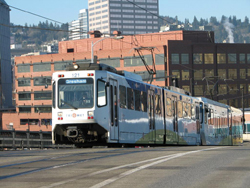
The Oregonian published a letter to the editor on Monday that I want to address. First, though, a warning: This letter contains references to towns such as “Happy Valley” and “Boring.” Those are the real names of these places, not sarcastic nicknames.
And now, the letter:
Every time I sit in traffic on Interstate 205 through Clackamas into Portland, my blood begins to boil. You see, construction work has begun to bring light rail to Clackamas Town Center. Precious land is being wasted on something that will never reduce congestion on I-205 (just look at the Interstate 84 corridor through Portland).
The urban growth boundary expansion into Happy Valley, Damascus and Boring will add a significant amount of growth to an area that is primarily serviced by I-205. All of these cars will end up on I-205, creating another traffic nightmare like we see on Interstate 5 every day.
Light rail will cost hundred of millions of dollars for approximately seven miles of track. With that kind of money, I-205 could easily be expanded to four lanes in each direction. This would be smarter growth and money well spent.
People will never give up the comfort and freedom of their cars in favor of public transportation, especially in a climate where it rains seven months a year.
ALAN GROSSO
Happy Valley
Regarding this statement:
“People will never give up the comfort and freedom of their cars in favor of public transportation.”
1. Well, not if you don’t even give them the chance, they won’t! It’s true, some people may never use light rail instead of their cars. But if that short-sighted attitude is made into public policy — “No one’s gonna use it, so let’s not even build it” — well, that’s sort of like saying that since a lot of people litter anyway, we might as well not even put garbage cans on sidewalks. Mass transit needs to be a viable option for people. Eventually, with cities growing the way they are, it will be the ONLY option for convenient, fast travel.
2. What Mr. Grosso really means, of course, is that HE will never give up the comfort and freedom of HIS car. A lot of other people will do so and have done so. Grosso seems to think that since I-84 is still crowded during rush hour, that must mean the light rail track that runs alongside it was a waste of money. But the trains on that track are full of passengers — passengers who would otherwise be on I-84, making it more crowded than it is.

As a matter of fact, Portland’s light-rail system, called MAX, carries about 100,000 passengers every weekday. (Many of those are duplicates, of course, with passengers making round trips.) There are 32.6 million MAX trips taken per year. It’s the fifth most ridden light-rail system in America, after Boston, San Francisco, Los Angeles, and San Diego (and it’s neck-and-neck with San Diego).
You’ll notice that all four of those cities have much larger populations than Portland. Now look at some of the cities that place below Portland in terms of light-rail ridership: Dallas, Philadelphia, Houston, Denver, St. Louis, Minneapolis, Pittsburgh, Baltimore. All have larger metro populations than Portland, yet Portland beats them all for light-rail use.
The bottom line? When you compare the number of residents to the number of mass-transit users, Portland’s ratio is better than nearly every city in America. TriMet reports that 43 percent of adults in the area use TriMet (bus, MAX, or Portland Streetcar) at least twice a month, and that 26 percent of the afternoon rush-hour commuters are traveling by TriMet rather than driving.
It’s true that I-205 should probably be widened, but not INSTEAD of putting light rail next to it. The reality is, it would be impossible to make I-205 (or I-84, or I-5) wide enough to accommodate all the cars that might want to drive on it. Eventually you get to the point where the freeway is as wide as it can possibly be without leveling every home and business on either side of it. And when that happens, your only option is mass transit — which Portland should be praised for having the foresight to work on now, before it becomes a crisis.
Maybe this is weird of me, but I’m fascinated by matters of civil engineering and city planning and traffic patterns and all that. My logical mind enjoys problem-solving, so when there’s a situation like congested traffic, I like to think of ways to fix it. This is the first place I’ve ever lived that had a good mass-transit system, and I use it regularly. I hardly drive my gypsy-cursed car at all. I fill up the tank once a month, on average, compared with the once-a-week system I had when I lived in Utah. So I’m delighted that Portland is expanding its light-rail system, and I’m glad not everyone thinks as narrowly as some locals do.




